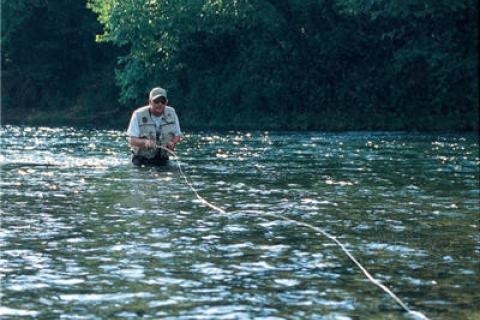
Of all the techniques involved in fly tying, spinning deer hair is one of the most challenging. Patterns that use this technique tend to be large and involved, often scaring away newly initiated tiers and the faint of heart. Don't be frightened. With a little practice and a few specialized tools, you, too, can create extremely cool looking flies that will flat out catch fish. Before we get into the actual step-by-step process, though, let's discuss the different types of hair that get spun, along with their unique properties.
Elk Hair for Fly Tying
Elk hair is coarse, straight and hollow. It is normally a light color, which helps make flies more visible in the water. Elk hair is buoyant and will keep your hair patterns riding high on the water's surface. Hair length is generally between one to three inches.
Moose Body Hair for Fly Tying
Moose body hair is straight, dense and approximately two to four inches in length. It is not hollow except at the base. In most cases, it is used for tails because it is stiff, durable and doesn't flare much. If a better alternative isn't available, it can be spun, but since moose body hair doesn't flare well, it isn't ideal in patterns calling for hair spinning.
Caribou Hair is Great for Learning How to Spin Hair for Flies
Caribou is a very fine, hollow hair that will spin very easily. This hair is a great tool for people learning how to spin hair, as well as for very small spun patterns. Caribou hair is typically a medium to dark brown color and approximately one to two inches in length. The one drawback to using Caribou hair is that it is not as straight as deer or elk. As a result, Caribou can be difficult to stack. But, if you clean the hair thoroughly from the under fur, it can be accomplished.
Deer Hair is a Good Choice for Spinning Popper Bodies
Deer hair is the number one choice for spinning popper bodies and Muddler heads. Deer hair is hollow and ranges in texture from fine to coarse. Typically, the longer the hair, the easier it is to work with, and the ideal spinning hair is usually one-and-a-half to three inches in length. Deer hair varies in color from light to medium-dark tan.
As we start the tying process, there are a few things to keep in mind. First, be sure to buy quality deer hair. The hair should be clean and long enough to spin. High quality deer hair will spin much more evenly than short, stiff hair. Second, be sure to use a strong thread. Weak thread will break off as spinning tends to require some torque. However, thread that's too thick or rigid can make controlling the hair difficult. Danville Flat Waxed Nylon Thread is generally considered one of the best for spinning hair. Finally, people often confuse spinning and flaring, which are two separate techniques. When hair is "spun" it goes around the hook shank; when hair is "flared" it stays in place.
Fly Tying Materials List
| Hook | Curved Shank Fly Hook |
| Thread | Danville Flat Waxed Nylon Thread (Black) |
| Hackle | Natural Deer Hair |
| Special Tools | Deer Hair Packing Tool |
Step-by-Step Instructions for Spinning Deer Hair
|
Step 1 Place your hook into the vice and secure it tightly in place. |
|
|
Step 2 Attach the thread to the hook shank at the point above the barb. |
|
|
Step 3 Collect a small bunch of deer hair (about the diameter of a straw) and clip it from the hide. |
|
|
Step 4 Clean the hair using a fine-tooth comb or toothbrush to make sure that none of the under fur is left at the base. |
|
|
Step 5 Place the hair on top of the hook shank and cover with two thread wraps in the middle of the hair. |
|
|
Step 6 Slowly increase the tension on the thread allowing the hair to spin and flare. |
|
|
Step 7 Pull the flared hair towards the rear of the hook and take one or two thread wraps in front of the hair to keep it in place. |
|
|
Step 8 Using a hair packer tool, push the hair toward the rear of the fly, and then place one more thread wrap in front of the hair to hold it in place. Remember: the tighter you compress the hair, the denser the body of the fly will be. |
|
|
Step 9 Repeat this process of tying the hair down, flaring it, packing it and tying it in place. Keep doing this until you reach the back of the hook eye. |
|
|
Step 10 Once you have the hook full of compressed hair, whip finish the thread, and then cut off the excess thread. |
|
|
Step 11 Invert the fly in your vice (or rotate your vice if you have a rotary model) and clip the bottom of the fly straight off. You can use scissors (more work) or a razor to do this. |
|
|
Step 12 Depending on the type of fly you are making, clip the deer hair in the desired shape. (Here we are making a popper style body.) Comb through the fly one final time with your bodkin just to make sure that no hairs were missed in the shaping process. Give one final trim and you are finished. |
|
|
Step 13 If you repeat the steps above, except this time on a hook that has a tail and hackle tied in, you will have a simple deer hair popper that's ready to tempt a few hungry bass. |
- 16762 views

